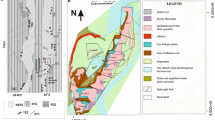Summary
Homogenization temperatures and salinity data are documented for fluid inclusions present in quartz from a Palaeozoic alkaline to peralkaline granite intrusion. A wide range of salinities (3.8 to 60.6 wt% NaCl equivalent) and homogenization temperatures (25.8 to 537 °C) indicates a sequential entrapment of different fluids, whereby the detected salinities decreased as a direct result of decreasing homogenization temperatures. Fluids were saturated with NaCl at 537°C and the development of hydrothermal solutions occurred at 1 100 ± 300 bars. Hydrothermal activity and the release of volatiles, F and B, during granite crystallization resulted in phlogopitization and tourmalinization of intruded metapelites. Volatile degassing, the presence of hypersaline hydrothermal fluids and contamination on the periphery of the intrusives by aluminous sediments led to the transport of K, Rb, Li, Mg, Cs, Be and Ta via halogen complexes from the granite system into the metapelitic aureole.
Zusammenfassung
Homogenisationstemperaturen und Salinitätsdaten von Flüssigkeitseinschlüssen in einer paläozoischen alkalinen-peralkalinen Granitintrusion sind dokumentiert. Eine weite Spanne von Salinitätsdaten (3.8 bis 60.6 Gewichts% NaCl äquivalent) und Homogenisationstemperaturen (25.8 bis 537 °C) deutet einen aufeinanderfolgenden Einschluß von fluiden Phasen an, wobei die Salinitäten mit verringerten Homogenisationstemperaturen abnahmen. Die Fluida waren bei 537°C mit NaCl gesättigt; hydrothermale Aktivität und der Verlust von Gasen, F und B, während der Granitkristallisation verursachte Phlogopitisierung und Turmalinisierung der intrudierten Metapelite. Entgasung, hochsaline hydrothermale Lösungen und Kontamination am Rande der Intrusionen durch Al-reiche Sedimente führte zum Transport von K, Rb, Li, Mg, Cs, Be und Ta als Halogen-Komplexe von der Granitintrusion in die metapelitische Kontaktaureole.
Similar content being viewed by others
References
Allman-Ward P, Halls C, Rankin A, Bristow CM (1982) An intrusive hydrothermal breccia body at Wheal Remfrey in the western part of the St Austell Granite Pluton, Cornwall, England. In:Evans AM (ed) Metallization associated with acid magmatism. J Wiley, New York, pp 1–28
Bowden P (1982) Magmatic evolution and mineralization in the Nigerian Younger Granite Province. In:Evans AM (ed) Metallization associated with acid magmatism. J Wiley, New York, pp 51–61
Burt DM (1975) Beryllium mineral stabilities in the model system CaO-BeO-SiO2-P2O5-F2O−1 and the breakdown of beryl. Econ Geol 70: 1279–1292
— (1981) Acidity-salinity diagrams-application to greisen and porphyry deposits. Econ Geol 76: 832–843
Charoy B (1982) Tourmalinization in Cornwall, England. In:Evans AM (ed) Metallization associated with acid magmatism. J Wiley, New York, pp 63–70
Coats RP, Blisset AH (1971) Regional and economic geology of the Mt Painter Province. South Aust Geol Surv Bull 43
—Callen RA, Williams AF (1973) Copley map sheet. Geol Atlas South Aust 1 : 250,000 series, Geol Surv South Aust, Adelaide
Grant JN, Walls C, Sheppard MF, Avila W (1980) Evolution of the porphyry tin deposits of Bolivia. Min Geol Japan, Spec Iss 8: 151–173
Gresens RL (1967) Composition-volume relationships of metasomatism. Chem Geol 2: 47–65
Hawthorne FC, Cerny P (1982) The mica group. In:Cerny P (ed) Granitic pegmatites in science and industry. Short course, vol 8. Min Assoc Can, Winnipeg, pp 63–98
Holloway JR (1976) Fluids in the evolution of granitic magmas: consequences of finite C02 solubility. Geol Soc Am Bull 87: 1513–1518
Kogarko LN, Burnham CW, Shettle D (1978) Water regime in alkalic magmas. Geochem Int 16: 643–651
Konnerup-Madsen J (1979) Fluid inclusions in quartz from deep-seated granitic intrusions, south Norway. Lithos 12: 13–23
London D (1986) Magmatic-hydrothermal transition in the Tanco rare-element pegmatite: Evidence from fluid inclusions and phase-equilibrium experiments. Am Mineralog 71: 376–395
Lottermoser BG (1985) Geology and genesis of a diatreme at Umberatana, 25 km west of Arkaroola, Northern Flinders Ranges, South Australia. Dipl Sci thesis. University of Newcastle, unpub
—Plimer IR (1987) Chemical variation in tourmalines, Umberatana, South Australia. Accepted
Norman DI, Trangcotchasan Y (1982) Mineralization and fluid inclusion study of the Yod Nam Tin Mine, southern Thailand. In:Evans AM (ed) Metallization associated with acid magmatism. J Wiley, New York, pp 261–272
Potter RW, Babcock RS, Brown DL (1977) A new method for determining the solubility of salts in aqueous solutions at elevated temperatures. US Geol Survey, vol 5, no 3, 389–395
—Clynne MA, Brown DL (1978) Freezing point depression of aqueous sodium chloride solutions. Econ Geol 73: 284–285
Roedder E (1984) Fluid inclusions. Reviews in mineralogy. Min Soc Amer, vol 12
—Coombs DS (1967) Immiscibility in granitic melts, indicated by fluid inclusions in ejected granitic blocks from Ascension Island. J Petrol 8: 417–451
Searson GJ (1975) Fluid inclusion studies of igneous rocks of the Mt Painter area, South Australia. BSc Hons thesis, University of Adelaide, unpub
Soboleva GI, Tugarinov IA, Golitsina NS, Knodakovsky IL (1984) The behaviour of Be in Fbearing hydrothermal solutions at 150-250 °C. Geochem Int 21: no 6, 20–30
Syromyatnikov FV, Makarova AP, Kupriyanova II (1972) Experimental studies of stability of beryl and phenacite in aqueous solutions. Internat Geol Rev 14: no 8, 837–839
Taylor SR (1966) The application of trace element data to problems in petrology. Phys Chem Earth 6: 133–214
Teale GS, Lottermoser BG (1987) Palaeozoic granites of the Umberatana region, South Australia: the role of volatiles in the crystallization of some alkaline-peralkaline granites. In prep
Tuttle OF, Brwen NL (1958) Origin of granite in the light of experimental studies in the system NaAlSi3O8-KAlSi3O8-SiO2-H2O. Geol Soc Amer Mem 74
Urabe T (1985) Aluminous granite as a source magma of hydrothermal ore deposits: an experimental study. Econ Geol 80: 148–157
Author information
Authors and Affiliations
Additional information
With 4 Figures and one Plate
Rights and permissions
About this article
Cite this article
Lottermoser, B.G. A fluid inclusion study of the Tourmaline Hill Granite, Umberatana, South Australia: Implications for hydrothermal activity and wallrock metasomatism. Mineralogy and Petrology 36, 135–148 (1987). https://doi.org/10.1007/BF01164486
Received:
Accepted:
Issue Date:
DOI: https://doi.org/10.1007/BF01164486




